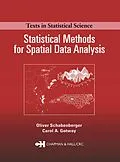Understanding spatial statistics requires tools from applied and mathematical statistics, linear model theory, regression, time series, and stochastic processes. It also requires a mindset that focuses on the unique characteristics of spatial data and the development of specialized analytical tools designed explicitly for spatial data analysis. Statistical Methods for Spatial Data Analysis answers the demand for a text that incorporates all of these factors by presenting a balanced exposition that explores both the theoretical foundations of the field of spatial statistics as well as practical methods for the analysis of spatial data. This book is a comprehensive and illustrative treatment of basic statistical theory and methods for spatial data analysis, employing a model-based and frequentist approach that emphasizes the spatial domain. It introduces essential tools and approaches including: measures of autocorrelation and their role in data analysis; the background and theoretical framework supporting random fields; the analysis of mapped spatial point patterns; estimation and modeling of the covariance function and semivariogram; a comprehensive treatment of spatial analysis in the spectral domain; and spatial prediction and kriging. The volume also delivers a thorough analysis of spatial regression, providing a detailed development of linear models with uncorrelated errors, linear models with spatially-correlated errors and generalized linear mixed models for spatial data. It succinctly discusses Bayesian hierarchical models and concludes with reviews on simulating random fields, non-stationary covariance, and spatio-temporal processes. Additional material on the CRC Press website supplements the content of this book. The site provides data sets used as examples in the text, software code that can be used to implement many of the principal methods described and illustrated, and updates to the text itself.
Autorentext
Oliver Schabenberger, Carol A. Gotway
Inhalt
INTRODUCTION
The Need for Spatial Analysis
Types of Spatial Data
Autocorrelation-Concept and Elementary Measures
Autocorrelation Functions
The Effects of Autocorrelation on Statistical Inference
Chapter Problems
SOME THEORY ON RANDOM FIELDS
Stochastic Processes and Samples of Size One
Stationarity, Isotropy, and Heterogeneity
Spatial Continuity and Differentiability
Random Fields in the Spatial Domain
Random Fields in the Frequency Domain
Chapter Problems
MAPPED POINT PATTERNS
Random, Aggregated, and Regular Patterns
Binomial and Poisson Processes
Testing for Complete Spatial Randomness
Second-Order Properties of Point Patterns
The Inhomogeneous Poisson Process
Marked and Multivariate Point Patterns
Point Process Models
Chapter Problems
SEMIVARIOGRAM AND COVARIANCE FUNCTION ANALYSIS AND ESTIMATION
Introduction
Semivariogram and Covariogram
Covariance and Semivariogram Models
Estimating the Semivariogram
Parametric Modeling
Nonparametric Estimation and Modeling
Estimation and Inference in the Frequency Domain
On the Use of Non-Euclidean Distances in Geostatistics
Supplement: Bessel Functions
Chapter Problems
SPATIAL PREDICTION AND KRIGING
Optimal Prediction in Random Fields
Linear Prediction-Simple and Ordinary Kriging
Linear Prediction with a Spatially Varying Mean
Kriging in Practice
Estimating Covariance Parameters
Nonlinear Prediction
Change of Support
On the Popularity of the Multivariate Gaussian Distribution
Chapter Problems
SPATIAL REGRESSION MODELS
Linear Models with Uncorrelated Errors
Linear Models with Correlated Errors
Generalized Linear Models
Bayesian Hierarchical Models
Chapter Problems
SIMULATION OF RANDOM FIELDS
Unconditional Simulation of Gaussian Random Fields
Conditional Simulation of Gaussian Random Fields
Simulated Annealing
Simulating from Convolutions
Simulating Point Processes
Chapter Problems
NON-STATIONARY COVARIANCE
Types of Non-Stationarity
Global Modeling Approaches
Local Stationarity
SPATIO-TEMPORAL PROCESSES
A New Dimension
Separable Covariance Functions
Non-Separable Covariance Functions
The Spatio-Temporal Semivariogram
Spatio-Temporal Point Processes
